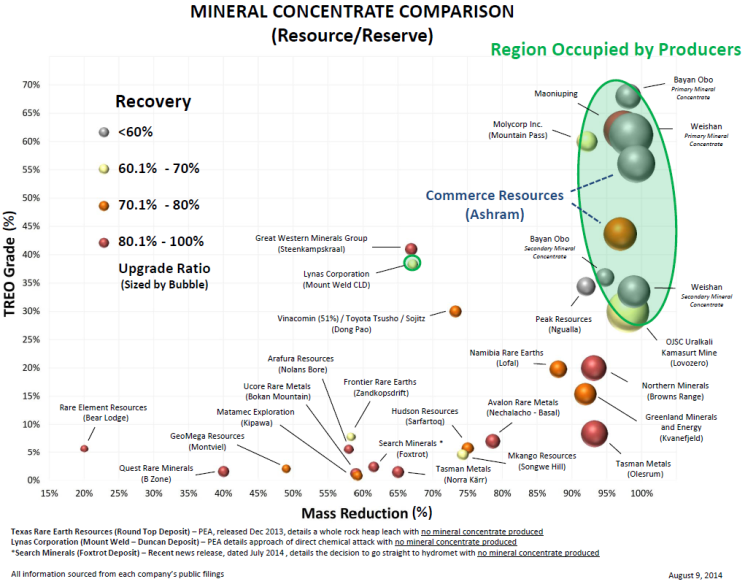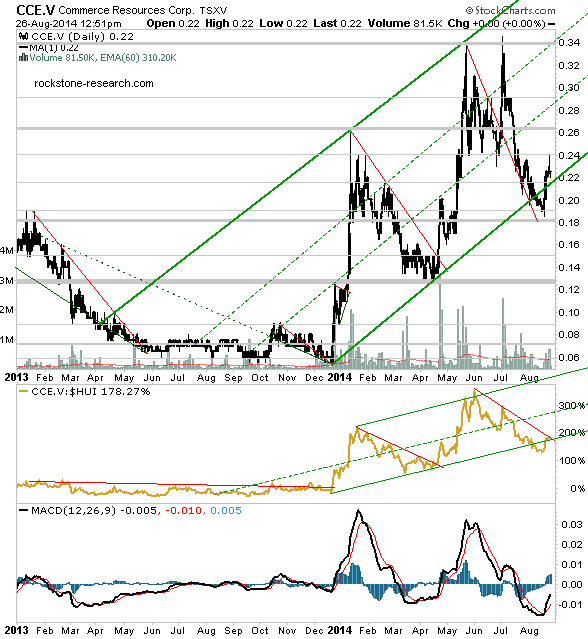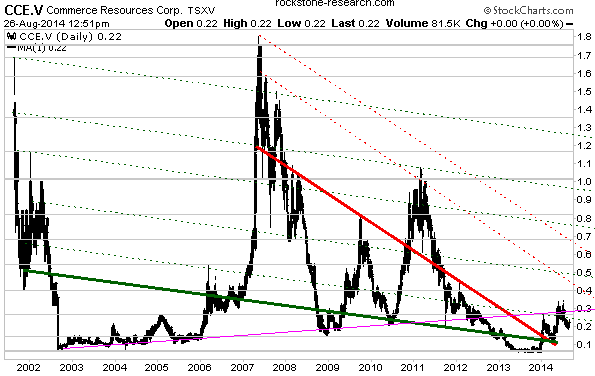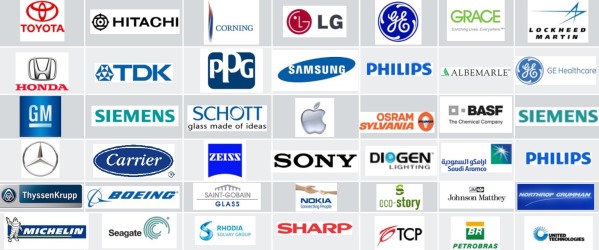Disseminated on behalf of Commerce Resources Corp. and Zimtu Capital Corp.
Currently, all major REE mines (apart from the ion-adsorbed clay deposits of Southern China) produce a minimum 30% TREO mineral concentrate as a necessary first step before further downstream processing. This fact is illustrated in the chart below from Dahrouge Geological Consulting Ltd. strongly indicating that it is a baseline requirement for economic REE mining perations since all downstream processes (the largest cost of the entire metallurgy process) are simplified with less volume requiring processing, i.e. costs are minimized. Furthermore, this becomes an easy first criteria to separate the top REE projects from the ones that lag behind in this respect.
*Economic Sense: Ultimately, the ability to produce a mineral concentrate as a first step preceding downstream processing needs to be achieved with positive economics, that is, within the context of current prices. Unfortunately, this is simply not the case even with current producers, such as Molycorp or Lynas. A junior or a major must be able to produce a product that they can sell at a profit at the current prices, or risk hemorrhaging capital as anyone can see both producers are. A junior or major has little to no ability to change 3 fundamental things: 1) the composition and mineralization of their deposit, 2) the cost to process the deposit, and most importantly, 3) the value of what is being produced.

In other words: Those REE deposits in development that have the greatest chances of success (i.e. being developed into a mine, and thus, offering the highest share price appreciation potential no matter if REE prices remain low) are those that host a REE mineralization out of which a >30% TREO mineral concentrate can be produced with an industry standard process that makes economic sense.
Bottom-line: Remember the acid! It is the most expensive single input to the flowsheet. More mass removed means less material to dissolve into solution, which means less acid consumption. Acid consumption will be discussed in more detail with our the next update.
Unfortunately for REE investors, today there exist not many undeveloped REE deposits hosting a mineralization out of which a high enough grade mineral concentrate can be produced, and easily processed, which would be saleable to global REE processors (also known as separation or refining facilities), and from which the numerous REE end-products, which are saleable to the industry, could be produced.
Thus, those few REE development companies capable of producing a >30% TREO mineral concentrate should (and will) be the focus of REE investors, if not already. According to our research only 3 active development companies have attained this base requirement:
• Commerce Resources Corp.:
44% TREO at 71% recovery, 56% TREO at <50% recovery
• Peak Resources Ltd.:
34% TREO at 52% recovery
• Great Western Minerals Group Ltd.:
47% TREO at 89% recovery
Which one will make it?
Peak Resources announced on August 7, 2014, a “beneficiation breakthrough” at its Ngualla REE Deposit in Tanzania: “The successful production of a mineral concentrate grading 34% TREO”, which is achieved by reducing the ore feed mass by 92% (8% mass pull, which means that only 8% of the whole ore must be treated with costly acid). Peak’s Managing Director, Darren Townsend said: “The ability to produce such a high grade, clean concentrate is an outstanding result that sets Ngualla apart from other rare earth development projects.” However, the recovery stands at 52% only. Thus, Peak’s metallurgical “breaktrough” needs further optimization, that is to say improving the recovery to appreciable levels (>60%) and further reducing the iron oxide minerals in the mineral concentrate, which are the main consumers of acid in the recovery stage. Time will tell if Peak succeeds in improving its recovery economically. Although significant grade and tonnage, Peak is a pure LREE deposit with no appreciable HREE component, limiting some of its development potential.
Great Western Minerals announced on June 20, 2014, the completion of a Feasibility Study (FS) for its Steenkampskraal REE Deposit in South Africa being able to produce a 47% TREO mineral concentrate at 89% recovery. However, the mass pull is relatively poor at 45% and the FS sees a mine life of only 13 years envisioning Steenkampskraal as a “small underground mining operation” with no resource expansion potential for additional mine life. The deposit also has a small annual production scenario in an effort to extend the mine life to a reasonable length. Time will tell if the company finds financing for such a small underground mine (total CAPEX is attractively low with $173 million only, but the total OPEX of $760 million appears daunting), because in the end it must make economic sense.
Commerce Resources announced in December 2013, the production of a 44% TREO mineral concentrate at 71% recovery and a mass reduction of 97% (3% mass pull) from the Ashram REE Deposit in Quebec, Canada. Most recently on August 19, Commerce published an update on the progress of the Pre-feasibility Study (PFS), and confirming Ashram’s processing flowsheet at the crucial bench scale. Ashram’s simple, and thus cost-effective, flowsheet has now proven to be repeatable for the production of a high-grade mineral concentrate (>40% TREO) using industry standard techniques applicable at the commercial scale. This is a stage most REE companies will brush over to produce an end-product for “show and tell”. However, the process is then not representative and typically far from economic. Commerce compellingly appears to have taken the proper approach to maximize its chances of success by way of developing a sound bench scale process, which is repeatable using industry standard techniques, and one that has achieved the apparent minimum 30% TREO mineral concentrate required for success. Time will soon tell how much abundant economic sense this all makes.
In early July, Commerce completed an infill drill program for its PFS yielding results that exceeded expectations as our interview with geologist Darren Smith from Dahrouge revealed. Mineralized material was found in the pit where waste was modelled in the PEA and, more importantly, the MHREO Zone was significantly expanded, where the highest valued rock is found. The 25 year mine life is set to increase with the upcoming PFS, whereas further expansion potential exists. Total CAPEX in the 2012 PEA stood at $763 million, whereas OPEX ($8/kg REO produced) is one of the lowest of all development projects in the REE space, followed by Ngualla ($12/kg REO) and Steenkampskraal ($13/kg REO).
Greenland Minerals & Energy Ltd. also enjoys one of the lowest OPEX ($8/kg REO), however total CAPEX is in excess of $1.5 billion for its Kvanefjeld REE Deposit in Greenland, where uranium mining is still an issue as the deposit is also enriched with that radioactive element. However most importantly, the Kvanefjeld Project is not capable of producing a high enough mineral concentrate as its 2012 PFS yielded a TREO mineral concentrate of only 15%. Time will tell if Greenland Minerals succeeds in developing a metallurgical flowsheet that makes economic sense and produces a high enough mineral concentrate of >30% TREO at appreciable (>60%) recovery.
Namibia Rare Earths Inc. announced in May 2014 the start of a PEA for its Lofdal REE Deposit in Namibia, whereas metallurgical tests have indicated the ability of producing only a 20% TREO mineral concentrate. Time will tell if improvements can be made without losing economic sense. Although an HREE deposit, Lofdal is a very small deposit at low grade. The lack of a meaningful tonnage is perhaps its greatest challenge.
With the exception of Greenland Minerals, all of the aforementioned companies have one important mine development criteria in common: The primary REE minerals have been processed commercially in the past or present. Other well-known companies with deposits hosting primary REE minerals with an unproven metallurgical flowsheet (that is to say REE minerals that have never been processed commercially) include Tasman Metals Ltd., Arafura Resources Ltd., Matamec Exploration Inc., Quest Rare Minerals Ltd., Avalon Rare Metals Inc., Ucore Rare Metals Inc., Texas Rare Earth Resources Corp. and Geomega Resources Inc. (not to say that they are all incapable of producing a high enough grade mineral concentrate but simply to point out their unusual mineralogy).
Why is it important to own a deposit with REE minerals that have been processed at the commercial level historically?
Because otherwise an entire new metallurgical flowsheet must be developed proving commercial viability, typically a time-consuming and soporific venture. In the REE space, this is often not possible. In 2011, Matamec did a joint-venture with Toyota and Frontier Rare Earths Ltd. with KORES (Korea Resources Corp., the wholly-owned mining and natural resource investment arm of the South Korean Government). Until today, both have invested significantly to find a way to economically process their specific REE-bearing minerals and rocks, eudialyte (Matamec) and laterite (Frontier) – until today, without much success as their TREO mineral concentrates continue to appear trapped well below 10%. Frontier has recently chosen to go straight to whole ore processing, a testament to the difficulty in processing of their material. Frontier basically gave up on producing a mineral concentrate. Time will tell if it makes economic sense to put the entire ore body into solution as acid consumption is the highest cost block in processing REEs. Remember the acid!
The latest news from Commerce continues to prove that the Ashram Deposit is leading the pack and that all peers in the REE space are lacking behind in terms of proving a metallurgy that works economically and with commercial viability. Ashram is the only REE development project that fulfills the crucial criteria of being able to produce a >30% TREO mineral concentrate at appreciable (>60%) recovery. The ongoing PFS is on the way of proving that this can be achieved with abundant economic sense, whereas Commerce is currently at the crossroads to have the potential to practically make any product that the REE market wants.
There exist numerous parameters to further improve the already robust economics of the project; as per CommerceÂ’s latest news of August 19:
“To date, no optimization testing has been completed (e.g. temperature, pH, reagent dosage, etc.). This suggests that significant scope remains for increased recovery. The next steps of optimization work will proceed in parallel with increasing focus on the production of a variety of potentially saleable end-product(s), using representative mineral concentrate feed material, in preparation for a full-scale pilot plant to be run before completion of the Prefeasibility Study.”
“The objective going forward is to optimize specific aspects of this mineral processing flowsheet. At the same time Commerce intends to initiate downstream processing studies directed firstly towards the production of a cerium-lanthanum depleted, and thorium free, mixed rare earth carbonate (REC) concentrate. This is one of many potentially saleable products which might be produced. It is the preferred feed stock for numerous global rare earth element (REE) processors. The company will also evaluate the production of select separated oxides as final products.”
“A mixed REO/REC concentrate is seen as a major milestone for the Company as it is a basic, relatively purified, feed stock for REE separation facilities, in and outside, of China. Ability to purchase such a concentrate aligns well with the interests of potential Joint Venture Partners who have excess separation capacity and need a concentrate source. Further, due to the high-grade nature of the Ashram mineral concentrates that are dissolved into solution (PLS), the impurity content is relatively low. Low impurities allows for more options and a potentially simpler means of downstream processing into relatively pure saleable product(s).”
“The versatility afforded by Ashram’s high-grade mineral concentrates (i.e. lower-cost downstream processing and limited impurities), allows for a greater number of potentially saleable products to be evaluated. Such versatility is sought after by potential Joint Venture Partners interested in partial/intermediate products. Options for partial separation will be evaluated as part of the next phase of hydromet work. Additionally, Commerce expects to evaluate the production of a range of separated oxide products, with a focus on the five critical REOs (CREOs) that the Ashram Deposit is enriched in. Final products such as neodymium oxide, europium oxide, terbium oxide, dysprosium oxide, and yttrium oxide would be attractive to a large number of end users and potential joint venture partners. They are therefore seen as viable commercial targets for the next stages of hydrometallurgical investigation.”
Going through CommerceÂ’s latest news release, we get the sense that, with all the technical details and language, it was written/addressed more to potential joint-venture partners than to the public. The next phase of metallurgical testing will deliver a detailed overview of the costs associated with producing the mineral concentrate as well as numerous REE end-products in order for interested parties to find out themselves how lucrative it would be to purchase the mineral concentrate (or even finished end-products) from Commerce, or as its President, Dave Hodge, put it:
“We are again very encouraged by the successful usage of the conventional and low-cost techniques detailed in the Ashram flowsheet. This testwork has produced one of the highest grade mineral concentrates in the REE sector and we believe that our current results are the most logical indicators of Ashram’s potential for positive downstream economics. We look forward to the results from the next phase of metallurgical testing and to a better definition of our costs to produce final end products.”
Thus, once details on the cost structure are disclosed in the upcoming weeks, we anticipate those to be highly profitable for processors of mineral concentrates and end-users even at current low REE prices. Hence, we expect a strategic partner to step up rather sooner than later.
Right Place @ Right Time
The Ashram Deposit is located in the Labrador Trough in northern Quebec, about 80 km north of Lac Otelnuk, the “largest iron ore deposit in Canada with the potential of becoming one of the largest in the world” according to Adriana Resources Inc. Lac Otelnuk has the FS scheduled for completion by year-end.

Numerous other prospective deposits occur in proximity as well being the main reason why the current liberal Quebec Government re-invigorated the “Plan Nord” on June 4:
“The plan, originally launched in 2011 under then-Premier Jean CharestÂ’s Liberal government, at that time promised $1.2 billion for infrastructure across QuebecÂ’s north...But the plan was put on ice with the 2012 election of the Parti Québécois, who re-branded Plan Nord as Le Nord pour Tous (the North for all.) At $868 million, the PQ plan came in at about $20 million less for infrastructure than its predecessor. The re-launched Plan Nord will operate with the $63 million invested into a Plan Nord fund for 2014-15. The new plan calls for the establishment of the Société du Plan Nord, to coordinate development with all of its partners, which the government says will include closer communication with Aboriginal communities.“
Other highlights of the 2014-15 budget include the investment of $90 billion on infrastructure over 10 years along with the creation of a Governmental Capital Fund to acquire equity stakes in mineral exploration, development and mining projects (“...so all Quebecers get a direct share of the profits from resource extraction”, as Northern Ontario Business Newspaper recently put it).
This investment fund is budgeted with $1.5 billion for 2014-2015 alone; thus Commerce may see some governmental support and participation as well, especially if a MoU (Memorandum of Understanding), off-take agreement, or strategic partnership contract is executed once the cost structure has been provided, which we expect to be happen shortly.
Thus, infrastructure – the only somewhat negative criteria when evaluating the overall feasibility of the Ashram REE Project – is turning out to materialize positively, and faster than expected. Commerce and its Ashram Deposit remain our top pick in the REE development space and is seen with highest potential for achieving economic production.

Technical Analysis
Commerce’s share price at the TSX.V has been outperforming the HUI mining index by around 200% since late 2013. Since our initial coverage, the stock appreciated by 283% – thanks to the metallurgical breakthrough announced in December 2013. So far, 2 distinct consolidation phases occured during the new upward-trend, whereas the second one appears to have ended a few days ago as the price started to increase back into the (green) channel, thus generating a buy-signal. We anticipate another strong decoupling phase from the HUI as soon as the (red) resistance is broken:


“There is a reason why the Rare Earths are called rare. They’re not called rare because they’re truly rare. They’re called rare because it’s very difficult to isolate these elements individually and it takes a lot of skill to do that.”
Constantine Karayannopoulos (former CEO of Neo Material Technologies Inc.)

Disclaimer: The author, Stephan Bogner (Dipl. Kfm., FH), owns shares of Commerce Resources Corp. and thus would profit from a share price appreciation, whereas the author may sell those any time without notice. Neither Rockstone Research nor the author was remunerated or instructed by Commerce Resources Corp. to produce or publish this content. However, please read the full disclaimer within the full research report (available as a PDF below) as a conflict of interest exists with Zimtu Capital Corp. and none of this content is to be construed as a "financial analysis" or "investment advice".
